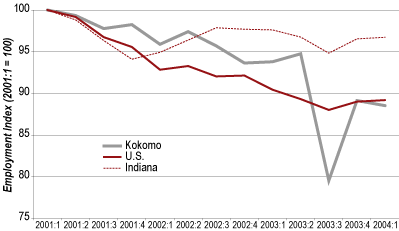Kokomo
Indiana University Kokomo
Kokomo’s economy remains heavily weighted toward manufacturing. Employment in manufacturing industries peaked statewide in June 2000, and while recent losses have been much less than before (and some months have even posted gains), employment has still not regained anywhere close to its peak. Like the rest of the state, individuals and firms in the area remain apprehensive about the economy and what it holds for them personally. While unemployment in the area peaked during 2002 and has since dropped, Kokomo had the dubious distinction of achieving the second highest unemployment rate in the country in July 2004 at 14 percent. Obviously, those numbers are way up from the pre-recession lows of about 2.5 percent, and July in Kokomo always seems to give horrible unemployment numbers. The unemployment rate did drop in August to the 5 percent to 6 percent level.
Many of the recent job losses nationally have been in transportation equipment manufacturing (vehicle parts), which is one of this area’s largest industries. From 2001 to 2003, industrial production declined nationwide but is finally showing some growth (see Figure 1). This area remains heavily invested in industrial production and very subject to economic disruptions as industrial production increases and decreases. The important news is that many of these job losses will be permanent due to increasing productivity, job losses to overseas, etc. This means that manufacturing production, while increasing somewhat, is unlikely to return to the glory days of the past.
Figure 1
Transportation Equipment Employment Index

Although the state and local loss of manufacturing jobs is still troubling, we think that the worst of the economic news is behind the region and we are optimistic about 2005 for the economy in general. Given the latest productivity, gross domestic product, and labor figures, it seems that the national and state economies are going to continue growing. This will certainly also be true of the local economy. But, as noted earlier, the relatively slow growth of employment has continued to be a prominent feature of this particular expansion. Recent trends show that employment is starting to pick up, giving a more favorable forecast for the area of about 3 percent to 4 percent growth—not outstanding, but not too bad either.
On the local front, past moves by the Fed to keep interest rates down and the incentives offered by the automobile manufacturers have kept auto sales fairly robust. This has protected jobs and production at the DaimlerChrysler plants, which are such an important part of this local economy. In addition, low interest rates have allowed consumers to continue buying homes, refinancing, and making home improvements. This can be seen all over the area in new home construction, building permit numbers, and new building construction. Help wanted signs are even beginning to appear in store windows. While these may not be the high-dollar manufacturing jobs that the area would like to see, it is at least encouraging to see hiring occurring and firms looking for employees. This is shown in the number of employees on nonfarm payrolls, which has increased in the Kokomo area by 5.5 percent since a year ago. But as noted in the national outlook, the Fed is likely to raise interest rates at least once in the next few months and that will potentially put a damper on the boost in sales due to manufacturers’ rebates and zero percent financing—unless the manufacturers still find it feasible to absorb the interest rate charges.
We must acknowledge that the manufacturing jobs that were so much a part of this area’s economy are leaving and are not likely to return. The type of jobs we would like to attract would be high-paying jobs, but those require a stronger focus on acquiring skills and education (both K-12 and higher education) than we may have exhibited in the past. This means we must get serious about education. To attract employers to the area, we must show that we have good schools, good students, good teachers, good graduates, and so on. We must also explore and develop partnerships between schools and work, between K-12 education and higher education, between institutions of higher education such as Ivy Tech and IU Kokomo—in short, we must reinvent ourselves for the twenty-first century. We simply must change or risk being left behind in the new economy.
Also in this Issue…



